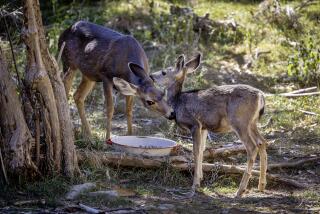Bones flesh out an island’s history
- Share via
The curator of the Catalina Island Museum opened the door to a musty backroom a few weeks ago hoping to find material for an upcoming exhibit on the World War II era. Closing the door behind him, he trudged down a narrow aisle lined with storage boxes and bins filled with gray photocopies of old letters, civic records, celebrity kitsch -- and dust.
“No luck,” curator John Boraggina muttered.
But as he made his way to a back corner, he noticed another row of boxes. He carried the largest to a table, blew off the dust and lifted the lid.
Inside were leather-bound journals and yellowing photographs showing freshly unearthed skeletons lying on their backs or sides, or curled as if in sleep. Many were surrounded by grinding stones, pots and beadwork.
Several photos showed a man in soiled clothes standing tall with spade in hand beside chaotic jumbles of bones. Boraggina recognized him: Ralph Glidden.
The images, Boraggina soon realized, came from a time 90 years ago that many on Santa Catalina Island had forgotten -- or tried to forget. The photos were of the work of a pseudo-scientist -- some say a huckster -- who made a living unearthing Native American artifacts and human remains for sale and trade. Glidden had ruined much of Catalina’s Native American cultural heritage, but in the process he also made discoveries thought lost in the passage of time.
Boraggina closed the big box and called the museum’s executive director, Michael De Marsche. “Michael, hurry over. I discovered something amazing,” he said. “I found Glidden’s archives.”
Minutes later, De Marsche was taking stock of enough historical photographs and handwritten documents to fill a gallery in the 60-year-old museum.
In the weeks since, the contents of the boxes have grown in importance. Researchers and scholars of California history --especially at UCLA’s Fowler Museum, where some 200 of Glidden’s skeletons are housed -- say the discovery will probably change the understanding of early life here and could eventually ease the anger of Native Americans outraged by the grave-robbing of the last century.
It is not often that a small-town curator unearths modern-day clues to a prehistoric past -- but scientists believe that’s what happened here
March 2.
Catalina -- a 76-square-mile land mass about 26 miles from the mainland -- was the home of Tongva Indians who buried their dead on the island for millennia.
Digging up those graves was Glidden’s business. The relentless collector and explorer excavated hundreds -- possibly thousands -- of burial sites on Catalina and other Channel Islands in the 1920s and ‘30s. Glidden’s penchant for making extraordinary claims generated headlines and expanded his markets for relics and remains.
In 1928, for instance, he discovered a massive soapstone urn on Catalina that he said contained the skeleton of a young “royal princess” crouched in an upright position with her fingers clenched over the rim. The urn, he told reporters at the time, was surrounded by the skeletons of 64 children buried in tiers four deep, “with each little head touching one another.”
About 5 feet below the children, Glidden said, was the skeleton of a man, 7 feet 8 inches tall, with a spear blade embedded in his left side. Glidden claimed it was evidence of a prehistoric race of giant fair-skinned, blue-eyed Native Americans.
No photographs of his unearthing of those remains are in the discovered boxes. But a 138-pound urn was a major attraction at Glidden’s “Catalina Museum of Island Indians.”
The museum, on a hill overlooking Avalon Harbor, was literally built of bones.
Newspaper articles from that era by publicist Alma Overholt describe it as a “unique and weirdly spectacular institution” with windows edged in toe, ankle, wrist and finger bones, and shoulder-blade cornices. Leg and arm bones served as brackets for shelves lined with skulls. Ceiling panels were decorated with vertebra and rosettes of shoulder blades.
Jeanne Hill, 89, a lifelong Avalon resident and historian, recalled how she hiked up the hill in the 1930s and paid Glidden 35 cents to look inside. “It was scary, very scary,” Hill said. “Bones piled up all over the place. One skull had a light on in it.”
“Years later, I came to doubt a lot of things about Ralph Glidden,” Hill continued. “Once, I found some receipts showing that he’d bought skeletons from a curio shop on Broadway in Los Angeles. There also used to be a fake archaeological dig site on the north end of the island that was assumed to have been Ralph’s work.
“Was a he a phony?” she asked rhetorically. “Well, it has been said.”
Professional archaeologist and historian Robert Wlodarski agrees -- to a point.
“Glidden tried to maximize profits any way he could,” Wlodarski said. “He also wanted to be a great scientist.”
Born in Massachusetts in 1881, Glidden was 15 when he moved with his family to the island.
In 1919, he was hired by George Heye of the Heye Foundation Museum of the American Indian in New York to supply his institution with Native American artifacts. Glidden’s subsequent expeditions into Catalina’s interior were authorized by William Wrigley Jr., who had just bought the Santa Catalina Island Co., which owns all the developable land on the island.
The recently discovered documents may have been compiled by Glidden to demonstrate to the Heye Foundation and other prospective funders “how wonderfully well he thought his research was going,” said the Catalina museum’s De Marsche.
Glidden’s museum closed in 1950. He spent the next several years trying to sell his collection to other museums and collectors. In 1962 the Wrigley family, which amassed a fortune from the sale of chewing gum, bought and donated it to the Catalina Island Museum.
An estimated 50,000 artifacts -- jugs, bowls, baskets, beads, amulets, rings, shell ornaments, grinding stones, cutting tools and arrowheads -- remain stored under lock and key on the island. Hundreds of bones, skulls and an estimated 30,000 teeth were initially lent to the UC Santa Barbara anthropology department. They were later moved to the Fowler Museum at UCLA.
Glidden was 87 when he died in 1968. The bulk of his journals, ledgers, letters and photographs were boxed up and forgotten.
The day of Boraggina’s discovery, De Marsche contacted Wendy Teeter, curator of archaeology at the Fowler Museum. As soon as she arrived, Teeter became entranced by the documents scattered across a table in Catalina.
Archaeologists had been unable to pinpoint exactly where, when or how the remains stored in an enormous temperature-controlled room in the Fowler Museum were collected, or even which ones were found on Catalina. Glidden had been prone to exaggeration and augmented his collection with skeletons acquired elsewhere.
“These are going to fill a lot of holes in the historical records,” Teeter said, handling the Glidden documents with white gloves.
“Wow. Incredible,” she said, shaking her head as she leafed through photo albums. “I think I recognize some of the remains he’s digging up in these photos.”
Forensic analysis of the photographs will help determine the exact origins of the remains and the causes of death, she said. “We’ll also glean new details about the culture and customs of the people who lived on Catalina thousands of years ago.”
The documents may also teach historians more about the man who produced them. “Glidden’s journals will tell us what made Glidden tick,” Teeter said.
Teeter already has begun assembling a team of experts to analyze the archive. Among them is Cindi Alvitre, who is completing a doctoral dissertation on the genealogy of Native American artifacts exhibited in museums after 1900.
“There were many collections similar to Glidden’s around that time, and they were mostly products of cultural cannibalism,” said Alvitre, a member of Los Angeles’ Tongva Gabrieleno tribe. “Ralph Glidden left our people in a state of constant mourning because he trashed the dignity and respect of ancestors who had been lovingly laid down in the ground during sacred ceremonies.
“I am confident that within my lifetime, the remains he robbed for personal gain will be returned to their proper resting place.”
The Catalina museum’s immediate plan is to inventory the collection, De Marsche said.
“Looks like we have a fascinating new back story to tell about Catalina’s heritage,” he said. “And it’s been sitting here, under our noses, for a half-century.”
--



